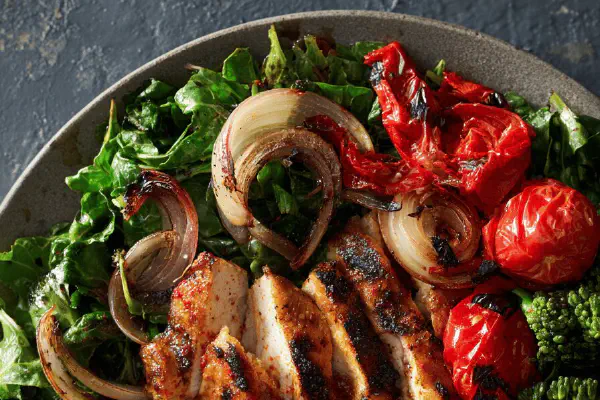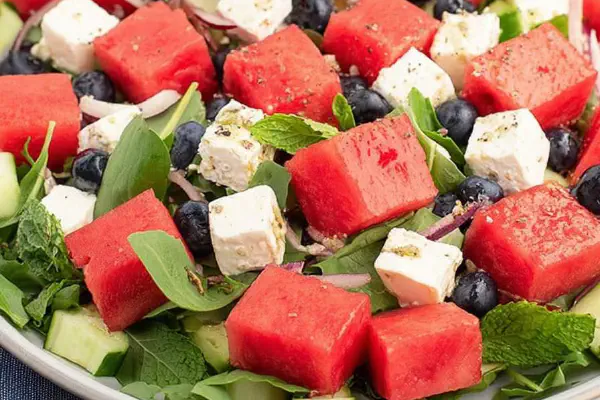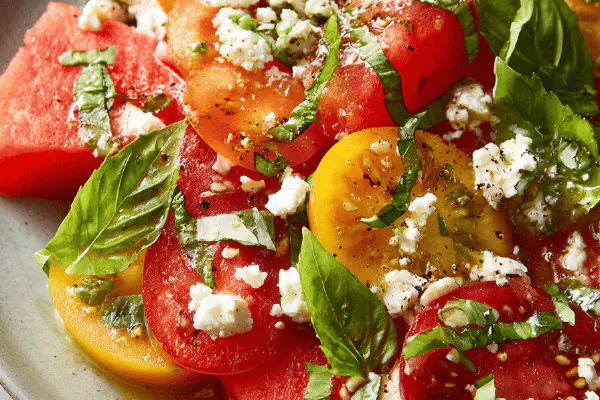Roasted Veggie Salad Feta Twist

By Emma
Certified Culinary Professional
Ingredients
- 400 g baby carrots peeled
- 300 g broccolini trimmed and halved lengthwise
- 350 g green beans trimmed
- 6 scallions cut into 4 pieces each
- 90 ml olive oil divided
- 30 ml sherry vinegar
- 2.5 ml dried thyme
- 200 g ricotta cheese
- 60 g crumbled feta cheese
- 50 g toasted walnuts roughly chopped
- 125 ml jarred spicy roasted red peppers chopped
About the ingredients
Method
- Set oven rack in middle position. Preheat oven to 235 C 455 F. High heat is key to quick roast, char, and moisture loss.
- Toss carrots, broccolini, green beans, and scallions with 55 ml olive oil on rimmed baking sheet lined with parchment or silicone. Season generously with salt and freshly ground black pepper.
- Spread in single layer. Roast 14-16 minutes stirring halfway until veggies are tender-crisp with brown spots — listen for faint sizzling and smell that sweet roasted aroma. Overcook, they'll mush; undercook, too raw.
- Meanwhile whisk remaining oil with sherry vinegar and thyme, salt, pepper. Thyme swaps oregano for earthiness; adjusts herbal profile to savory brightness.
- Divide ricotta into four shallow piles on plates for base. Spoon veggies evenly on top. Scatter feta, walnuts, diced roasted peppers over salad.
- Drizzle vinaigrette just before serving. The sharp pepper notes balance creamy ricotta and salty feta.
- If no broccolini, substitute tender broccoli florets but roast a bit less as they cook faster. Carrot size affects timing; too thick means longer roast.
- No sherry vinegar? Use white wine vinegar or mild apple cider vinegar. Walnut allergy? Use pistachios or sunflower seeds.
- Want more tang? Add a squeeze fresh lemon juice to dressing just before drizzling.
- Note fresh herbs lose potency under heat. Adding dried thyme to dressing preserves fragrant hit.
- For cleanup, line pan with parchment or silicone if you dislike scrubbing baked-on caramelized sugars.
- Don’t crowd veggies; if crowded, roast in batches for even caramelization and crispness.
- Store leftovers in airtight container; reheat gently or enjoy cold for different texture experience.
Cooking tips
Chef's notes
- 💡 High heat roasting key. Oven at 235 C means fast moisture loss. Watch color carefully — golden-brown spots tell when to pull. Stir halfway to avoid burnt edges. Carrot thickness always changes timing. Thin means quicker; thick needs more time but risk mush if too long. Use tongs to test firmness. Veggies should snap but not raw.
- 💡 Season veggies before roasting. Salt pulls moisture out for better caramelization. Oil spread evenly to avoid dry patches and prevent sticking. Rimmed sheet pan catches runaway oil splatters — oven hits hard at this temp. Char smell and faint sizzling sounds are cues. No char, no flavor punch; overcook and mushy mush. Balance here is crucial.
- 💡 Dressing made separately keeps olive oil brightness. Whisk oil with sherry vinegar plus dried thyme, salt, and pepper. Thyme swaps oregano for earthiness—adds herbal depth, prevents bitter notes under heat. Add vinegar slowly to adjust acidity. Drizzle just before serving keeps walnuts crunchy and herbs fresh. Napkins ready, dress late to avoid soggy texture.
- 💡 Substitutions matter. No broccolini? Use broccoli florets but cut smaller and watch shorter roast time. Walnut allergy? Pistachios or sunflower seeds add crunch without overpowering. No sherry vinegar? White wine or mild apple cider vinegar brightens without syrupy sweetness balsamic brings. Always taste vinegar amount carefully; acidity varies by brand.
- 💡 Keep nuts toasted but not burnt — bitterness kills dish. Toast walnuts lightly in dry pan; smoky aromas develop fast. Use diced roasted red peppers to add subtle heat and smoky flavor replacing spicy eggplant type. Carrots have sweeter notes than asparagus, so choose based on your flavor edge. Avoid overcrowding pan; steam kills roast flavor and crispness. Roast in batches if needed.
Common questions
How to tell when veggies are done?
Look for char spots, brown edges, faint sizzle from oven. Break a carrot with tongs; firm but not raw. No mush. Listen and smell too — sweet roast aroma hits when ready. Overcook means limp mess, undercook raw crunch.
What if I don’t have sherry vinegar?
Try white wine or apple cider vinegar. Keep acidity subtle. No syrupy balsamic here; acidity brightens without heaviness. Add lemon squeeze for tang boost if you want extra brightness. Adjust by taste, vinegar strength varies.
Can I use other nuts?
Pistachios or sunflower seeds work well if allergic to walnuts. Toast them gently. Raw nuts lack depth. Pecans replaced here for a deeper smoky buttery profile. Toast nuts separately to avoid soggy texture, fold in last.
How to store leftovers?
Airtight container mandatory. Reheat gently in oven or microwave to avoid mush. Or eat cold for different texture, crunch fades but flavors concentrate. Roasted veg hold flavor longer than steamed. Dressing can be stored separately to keep nuts crisp.



